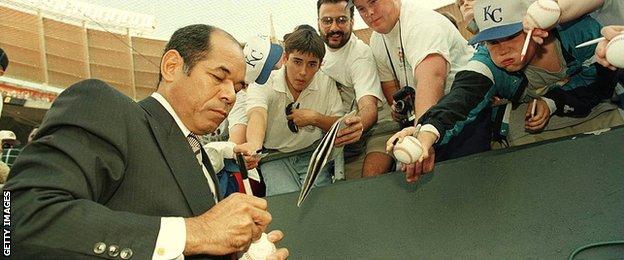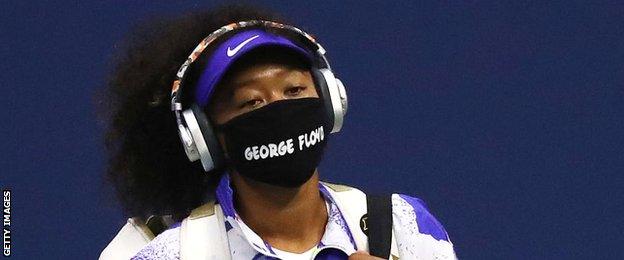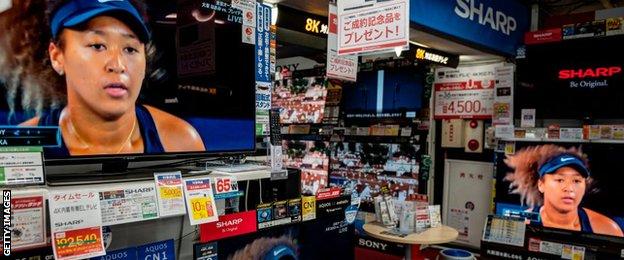

Naomi Osaka tells a story.
It is from Florida, where the world’s best young tennis players congregate and compete.
Osaka, aged about 10, was getting ready for a match at the prestigious Orange Bowl tournament.
Preparing within earshot of her Japanese opponent, Osaka overheard her conversation.
“She was talking with another Japanese girl,” Osaka told the Wall Street Journal.
“And they didn’t know that I was listening or that I spoke Japanese.
“Her friend asked her who she was playing, so she said ‘Osaka’. And her friend says, ‘Oh, that black girl. Is she supposed to be Japanese?’ And then the girl that I was playing was like, ‘I don’t think so.'”
Everyone knows now. Osaka, the US-raised daughter of a Japanese mother and a Haitian father, is the face of Tokyo 2020.
At every bus stop in Tokyo, the 23-year-old stares down from an advert, greeting passengers local and international. She is decked out in a neon pink jacket over black activewear.
The slogan is written half in English, half in Japanese. It is the word ‘new’, followed by a symbol that can be translated either as ‘world’ or ‘generation’.
It works. Because Osaka, who renounced her US citizenship in 2019 in favour of her Japanese heritage, is bringing more than titles back to her homeland. She’s bringing change.

You don’t have to go back to Osaka’s childhood to find doubts over how she fits into Japanese society.
“To be honest, we feel a bit of distance from her because she is so physically different,” said Nao Hibino, currently Japan’s number three, as Osaka was moving into the top echelons of women’s tennis in 2018.
“She grew up in a different place and doesn’t speak as much Japanese.
“It’s not like Kei (Nishikori), who is a pure Japanese player.”
She is not the first mixed-race or ‘hafu’ sportsperson to pose such questions.

Sachio Kinugasa and Hideki Irabu were baseball stars.
Neither they nor the Japanese public were interested in talking about their American fathers, soldiers occupying the country after the Second World War, or the discrimination they faced.
Osaka is different.
“Some older people have set ideas about how a Japanese female athlete should speak and behave in public,” explains Hiroaki Wada, a reporter for the Mainichi newspaper in Japan.
“Naomi doesn’t fit in that traditional mould. She made those issues very visible through her words and actions in Japan.
“Race and identity got discussed more in the media and online because of her, including her political statements. She is a thought and reaction-provoking figure.”
Osaka entered the players’ bubble at last year’s US Open with a plan. She packed seven different face masks. One for each round of the tournament. Each with the name of a black American who died because of alleged police or racist violence.
She used every one, displaying the names of George Floyd, Breonna Taylor and Trayvon Martin to a global audience on her way to the title.
It a subject that Japan, one of the least ethnically diverse nations on earth, still struggles with.

Japan’s public broadcaster NHK apologised last year after an animated film explaining protests for racial justice caricatured black people and excluded some of the key reasons for the movement.
In 2019, Japanese instant noodle company Nissin made, and then pulled, an advert with a white-skinned manga illustration of Osaka.
It runs a generation deeper as well. Osaka’s mother and father migrated to the United States, when she was three, cut off by her disapproving maternal grandparents.
“I think what has happened is the past year or so has been a learning process for the Japanese,” says Robert Whiting, author of Tokyo Junkie, a book that details his nearly 60 years living in the city.
“There has been discussion on television variety shows, explaining why Naomi felt that way and has spoken as she has.
“In Japan, the tradition is to avoid conflict and argument. It’s not like in America where you have that public to-and-fro.
“Generally the more famous you are the more tight-lipped you are. You don’t want any controversy, you don’t want it to reflect on your team-mates, your organisation or sponsors.
“Individualism is a very valued thing in the West, not in Japan. Here, harmony is the most important thing.”
If last year was about where Osaka was from, this year has been about where she’s at.
In May, after initially saying she would not talk to the media during the French Open, she pulled out of that tournament and then Wimbledon, citing her poor mental health and long bouts of depression over the previous three years. The Tokyo Olympics are due to mark her return to the court after two months.
She is the most high-profile, but far from only, Japanese personality to raise the issue of mental health in the public eye.
International footballer Kumi Yokoyama, 27, revealed last month that they were transgender and intended to transition fully to a man once they had retired from the sport. They explained how playing in the United States and Germany had made them aware of ignorance and prejudice in Japan.
In 2020, Hana Kimura, a professional wrestler, took her own life after appearing in Terrace House – a popular reality show.
In the general Japanese population, the number of people reporting mental health problems has doubled from 1999 to 2014.
“Traditionally in our nation, looking back as a kid, 40 years ago, it was shameful if you or a relation had a mental health problem,” said Wada.
“In general the perception of weakness, probably more so among athletes, has kept people from talking.
“But things are changing. People are becoming more open to admitting people have mental health problems and they are something we have to deal with.”
And Whiting has no doubt where that change is coming from.

“I think Naomi Osaka and other mixed-race Japanese are still outsiders to a degree,” he says.
“But this generation of Japanese is much more sophisticated than previous generations, they are much more global in their outlook with the internet and countless TV channels.
“There is a broader understanding that wasn’t there when I arrived in the 1960s or in the ’80s and ’90s. The world is a much smaller place now and Japan has benefitted from that.”
New world. New generation. However you translate it, Osaka is a big part of it. – bbc.com